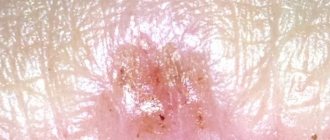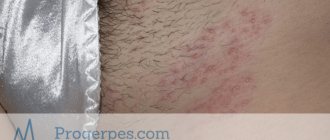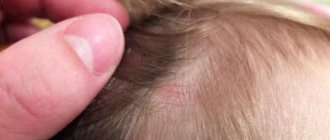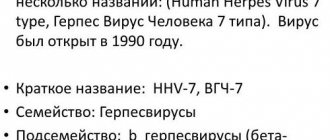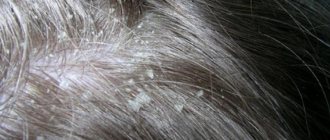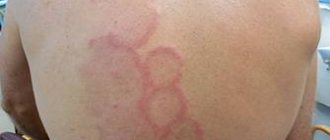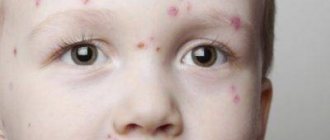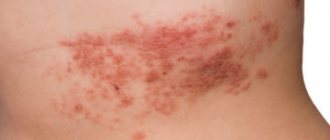One of the main features of the herpes virus is its ability to infect any area of the skin and mucous membranes. Herpes on the neck is one of the rather severe clinical manifestations of this virus.
90% of people are carriers of various types of herpes virus, and it is usually present in the body in a latent, hidden form
, becoming more active during any weakening of the immune system.
The skin of the neck is highly sensitive, so rashes on the neck are especially unpleasant. And constant touching of hands or clothing to this part of the body can provoke a secondary infection.
Where does herpes come from?
The most common disease in the world is herpes. The virus can stay in our body for a long time and not bother us; some are infected with it from birth; until a certain period it does not cause discomfort. But various factors can cause its activity.
Many have encountered the fact that before exciting events in our lives, a herpetic rash may appear, which from a watery blister turns into a crusty wound. The rash most often appears on the mucous membrane, but herpes can also appear on the neck.
The herpes virus has four degrees of progression:
- First stage . Manifestations of the herpes virus begin with itching, red spots and stinging. If you use acyclovir at this stage, you can stop the disease in the bud.
- The second stage of the disease is manifested by a rash in the form of watery pimples. The bubbles enlarge and can merge into one, and the liquid inside them becomes dark and cloudy. With such an acute manifestation, you should definitely see a doctor.
- The third stage of the disease is characterized by the bursting of bubbles, while the sick person becomes a carrier of the disease and can infect others.
- The fourth stage of the disease is the healing of wounds with a crust, which means that the acute stage has passed, but treatment must be continued.
If herpes appears frequently on the neck or other places, then the most important thing is not to miss the first stage, otherwise the disease may become chronic, and you will have to make a lot of effort to get rid of it.
Herpes lesions on the neck can develop into a very severe form, and treatment will be long and difficult.
Minor signs
In addition to the herpetic rash, the disease is characterized by an inflammatory process, which has the addition of general intoxication. It is expressed:
- elevated temperature;
- dizziness;
- nausea;
- insomnia;
- sleep disturbance;
- inflammation of the lymph nodes.
Location of lymph nodes
Lymph nodes can become inflamed not only behind the ears, but also in the armpits. To find out exactly, an examination by a therapist is necessary.
Why does herpes occur?
In the modern world, there are more than two hundred different viruses that cause herpes. Approximately 95% of the world's population carries this disease.
Herpes on the neck is caused by certain pathogenic types of viruses. It most often affects the mucous membrane of the lips or the mucous membrane of the genitals, but can also be transferred from one part of the body to another.
Any touching the areas affected by the rash can cause the disease to be transferred to healthy areas. The cause of lesions on the neck or head is herpes zoster. It causes a lot of trouble, severe itching and weeping wounds.
Like any type of virus, rashes on the neck have several stages. The first sign is redness of the skin and unpleasant itching. Then bubbles with liquid appear, the itching intensifies, and the temperature may rise.
Herpes on the neck
Causes of herpesvirus infection, risk factors
The appearance of a rash on the neck is not always caused by this virus. To find out the exact diagnosis, you should consult a doctor. It manifests itself as a result of decreased immunity. Also, the causes of the disease can be:
- infectious diseases;
- stressful situations;
- weakening of the body due to alcohol intoxication;
- radiation therapy;
- organ or bone marrow transplantation;
- drugs that have an immunosuppressive effect.
How to treat herpes
Herpes on the neck is a viral disease that very often occurs due to stress or decreased immunity. Therefore, it is very important to start treatment on time and strengthen the body’s immunity.
The sick person should start taking vitamin supplements and immunomodulators, such as interferon. It is important to get the required dose of vitamin C, A and E, as well as B.
These substances fight the virus and help restore the skin. And most importantly, they prevent herpes from entering the body, increase the level of white blood cells, and also promote the natural production of interferon.
An excellent option for boosting immunity would be to take tincture of ginseng or echinacea. Interferon can also be used in the form of compresses on areas of skin with rashes. You can apply camphor or fir oil to the rash areas.
Possible complications of herpes on the neck
Complications in this case occur quite rarely, but it is necessary to be aware of them. In the absence of adequate treatment, the following consequences are possible:
- Postherpetic neuralgia, accompanied by severe and constant pain caused by nerve damage;
- Damage to the organs of vision;
- Brain damage;
- Attachment of a secondary bacterial skin infection.
As we see, an exacerbation of herpes is fraught with the development of a number of side effects . Taking antiviral and immunomodulatory drugs to treat complications of herpes is possible in conjunction with traditional medicine (herbal decoctions and tinctures) and hardening the body. If agreed with your doctor, regular exercise and visiting a sauna (bath) are also useful.
Signs of the disease in adults
Redness appears on one or both sides of the neck, it begins to itch and hurt, the lymphatic ducts may become inflamed, the temperature rises, and general health is characterized by unpleasant pain throughout the body.
If treatment is not started during this period, vesicles appear that grow and fill with fluid. In this liquid, which becomes cloudy over time, there is a virus that is very dangerous for others, because if it gets on another person, it will cause illness.
After a while, the wounds begin to secrete ichor, they may even bleed, then they become crusty, and the acute stage subsides. But this does not mean that the disease goes away; at this stage it is very important to continue treatment, since such herpes can develop into a chronic form and bother you at the slightest decrease in immunity.
Treatment methods
The main goal in treating the disease is to stop the activity and spread of the virus. The treatment process is carried out comprehensively.
The following drugs are used:
- antipyretic medications;
- immunity-strengthening vitamins;
- antiviral drugs;
- analgesics.
A greater effect from treatment can be obtained by starting treatment at the initial stage of the disease.
Ointments
- Acyclovir – has an antiviral effect. The ointment is applied in a thin layer to the affected skin and around it with a cotton swab. The process should be carried out every 5 hours for 10 days.
- Fenestil - Pentsivir - blocks the virus and prevents its reproduction. Can be used by patients over 12 years of age. The ointment should be applied to the affected areas of the skin every 2 hours for 4 days.
- Plant gel Panavir - helps block viral DNA synthesis. You can use the gel 5 times a day. Duration of treatment – 6 days.
Pills
- Preparations based on valacyclovir. Use the drug 3 times a day, 1,000 mg. The course of treatment is 7 days. It should be noted that side effects are possible: nausea and headache.
- Preparations based on acyclovir. It is recommended to take the medicine up to 800 mg, 3 times a day, every 8 hours. It is recommended to drink plenty of water during the course of treatment.
- Preparations based on famciclovir. You need to take the drug 3 times a day, 500 mg. For a patient with good immunity, the duration of treatment is 7 days. In case of weakened immunity, the course of treatment is 10 days. Used in the treatment of herpes zoster.
It should be noted that vitamins E, B, C and ascorbic acid play an important role.
In addition to medications, propolis and garlic extract and breast milk have good antiviral properties.
Manifestation of herpes in children
Children are susceptible to herpetic lesions no less than adults. The virus in a child’s body is capable of actively growing and aggressively affecting health.
It is very important to detect the appearance of herpes in a child at an early stage. Therefore, parents need to be vigilant and, at the slightest hint of herpes symptoms, seek advice and begin the correct treatment.
The virus can infect infants. Despite the fact that from birth we are vaccinated against various diseases, herpes can live in the human body from birth.
The first thing you need to pay attention to is the child’s well-being. If he complains of frequent headaches, is moody, or has swollen lymph nodes, he should go see a doctor and get tested.
A more obvious sign of the appearance of herpes on the neck is redness of areas of the skin, as well as a small small rash. This rash can easily be confused with miliaria, which is common in young children.
But the first small bubbles may already appear on it. If you notice such manifestations, contact your dermatologist immediately.
The most obvious sign of herpes is blisters with liquid that can surround the neck. This is the so-called shingles, which is very dangerous and can affect large areas of the body. With this manifestation of herpes, it is very important to complete the full course of therapy.
Signs and symptoms of the disease
The development of the disease occurs in 4 stages:
- Itching appears, the skin turns red and tingles. Scratching it is accompanied by inflammation.
- Ulcers form on the affected area - a large number of small blisters filled with liquid. There is increased itching and burning.
- The bubbles increase in size and burst.
- The last stage is the healing of the blisters. They become covered with a dry crust.
The stages of development of the disease are accompanied by symptoms:
- loss of appetite;
- lethargy;
- increase in body temperature up to 40°C;
- headache;
- enlarged cervical lymph nodes;
- shooting pains radiating to the jaw, head, ear or chest.
How to detect the disease in a timely manner?
For people who are exposed to the herpes virus for the first time, it is necessary to know the key symptoms of this disease. It is worth noting that the rash does not appear immediately. A red tint appears at the site of the future rash, along with itching and a slight burning sensation. Only after overcoming these symptoms does an unpleasant rash of small pimples appear.
The affected area not only hurts, but also looks very unpleasant. Because of this, many people with herpes experience not only physical pain, but also psychological discomfort.
Causes
Due to the fact that the herpes virus has the unique ability to mutate and rewrite its DNA to survive in various parts of the human body, there are already over 200 varieties of this pathogenic microorganism. In this case, a herpetic rash on the skin of the neck can occur only due to infection with the following genotypes of a viral infection:
- Herpes types 1 and 2 are one of the most common forms of this dermatological disease. In most cases, the localization of the rash is the lips and the circumference of the oral cavity, but sometimes the virions get on the skin of the neck and then the epidermal tissues of this part of the body are damaged.
- Shingles. This is a type of herpes virus that covers the entire length of the skin of the neck from the collarbone to the uppermost segments of this part of the body. If timely medical treatment is not carried out, the rash can spread to the scalp.
- Cytomegalovirus and Epstein-Barr virus. Genotypes of herpetic infection, penetration of which into the epithelium of the neck, also cause the appearance of a red rash, transforming into watery blisters with the further formation of multiple erosions. In parallel with this, the dermatological disease also provokes the development of infectious mononucleosis.
- Herpes genotype 6. In dermatology, such rashes caused by herpetic infection genotype 6 are also called pseudorubella due to the prolonged period of presence of red pimples on the neck without filling them with watery liquid. In general, the general symptoms are the same as with herpes genotypes 1 and 2.
These diseases are the main reason why herpetic rash affects the skin of the neck. The development of the disease is possible only if the protective function of the immune system of the infected person is weakened.
Preventive actions
General preventive measures to prevent herpetic rash on the neck in an adult are:
- Conducting vaccinations. Doctors use the drug, which was approved in the early 2000s after conducting large-scale clinical studies involving more than 40,000 people (age 60+ years). The study findings indicate that the use of the vaccine can reduce the incidence of exacerbation of the Zoster virus by more than 50%. Zostavax is intended for single, intradermal administration. The preventive effect after administration is observed for 3-5 years. Before starting to use the described vaccine, you must consult a doctor, and also take into account possible contraindications and side effects that may occur during the use of the drug.
- Directing efforts to strengthen the immune system: implementing hardening procedures, daily walks in the fresh air, moderate physical activity. It is recommended to give up bad habits and introduce a sufficient amount of fresh fruits and vegetables, fermented milk and dairy products into the diet. Patients should also refrain from systematic psychophysical overexertion.
In order to prevent a herpetic rash on the neck of a child, it is recommended to adhere to the following recommendations:
- Isolate a healthy child from other patients.
- It is necessary to reduce to zero the likelihood of contact of healthy children who have not been vaccinated and do not have a history of chickenpox (chickenpox) with infected people.
- It is important to observe the rules of personal hygiene: use your own clean towel, household items, clothing, etc.
Children are also recommended activities aimed at strengthening the immune system: walks in the fresh air, physical education, healthy sleep for at least 8-9 hours, a balanced, healthy diet.
